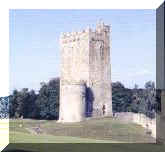|
|
|
| The lovely castle and grounds of
Drishane are situated a little to the northeast of Millstreet, near where
the Finnow river joins the Blackwater. The castle is in fine condition, although not lived in. The castle was built by the MacCarthys and the date given for its construction varies between 1436 and 1450 |
 |
It seems likely that it was commenced by Dermot Mór, the second son of Teige the 3rd Lord of Muskerry, who was a direct descendant of Diarmuid, King of Cork. Dermot also is said to have built Kilmeedy and Carrigaphooca in the great period in which his brother, Cormac Láidir, was building Blarney and Kilcrea. Dermot died in 1448 and Drishane was probably completed by his son, another Dermot.
The denealogy for the MacCarthy family in general is confusing, particularly since Christian names are so often repeated, but the account of the Drishane branch varies considerably in differing renderings. For instance it is several times stated that there were two centenaries in the family, both named Donogh. From a study of the documentation available - admittedly scanty at times - it seems likely that there may have been only one: the second Donogh, who is buried in the castle grounds and lived 1597 1719 to an age of 122 years.
Some authorities state that the first Donagh lived from 1517 - 1639. Documentation clearly shows that Teige, son of Owen was in possession of the property in 1592 when he surrendered it to the Queen and got a re-grant. If Donagh was still alive he would, probably at least, have been the property owner.
Teige died before 1624, when there was an inquisition on his
lands, and in a further inquisition of 1638, his son Owen Mac Teige is described
as being in possession of Drishane Castle at his death in 1637. The
latter's son, Donogh MacOwen, the centenarian, inherited. He was over 40
at the time (which would confirm a birth date of 1597) and had married Kathleen
Fitzgerald, who also died in 1637. It would appear from other information
that he married a second time.
Owen had brothers named Callaghan, Donogh and Phelim (on whom I have little
information) as well as Dermot who was killed leading a squadron of horse at the
battle of Knockbrack in 1652 - the end of resistance to the Parliament in the
area. Donogh mortgaged Carriphooca to Dominic Coppinger before 1641 -
probably to raise funds for the Confederate War.
All MacCarthy lands were finally forfeited at the end of this tragic period, but were restored to the Earl of Clancarty, overall head of the family, on the restoration of Charles 11 in 1660. He granted a lease in 1677 to Donogh: and this lease was passed with the proviso that Donogh settled what was due to Coppinger.
The MacCarthy lands were finally forfeited following the Jacobite period of 1690 and Drishane fell into the hands of the Hollow Sword Blade Company, an organisation which had financed William's campaign in Ireland. In 1709 they sold to Henru Wallis of Ballyduff, Co Waterford, a younger son of Thomas of Curraglass (Mogeely), where the family had been resident since 1596.
There is some doubt also about the date of the first connection of Wallis with Drishane. Renovations were carried out at the castle in 1643 according to the date on a fireplace, and this bears the inscription "W" suggesting "Wallis".
It is further suggested that Wallis shared a friendship with Donagh MacCarthy, and that he allowed the latter to live in peace at Drishane during his lifetime. Another account states that Donogh demised part of the land to Henry Wallis; and after Donogh eventually died in 1719 his widow, in 1722 and 1724, leased her interest in the remaining lands to Thomas Wallis, son of Henry.
The Wallis' turned Protestant and 'discovered ' the property under the Property Act and so purchased what remained of Drishane for £450 (it was valued at £8000) in 1798. This led to a horrendous local tradition that Donogh's widow died on the doorstep of the castle from exposure, but in reality (since the exchange of cash was involved) the transaction may have been to clarify the entire matter because of claims being made by the widow's relatives, the O'Learys, to the property.
By the time Doctor Smith wrote his History of Cork in 1750 he was recording that there as a handsome new house near the castle built by the late William Wallis who had considerably improved this part of the country, by manuring it with lime, enclosing planting etc.
In fact the Wallis' appear to have been popular in the neighbourhood and remained there until 1882 when the estate was placed in Chancery on an application of insurance companies, and there it remained until 1912 when it was sold before Judge Roy to Patrick Stack of Fermoy from whom, through the offices of Cornelius Duggan of Cork, it was passed to the Dames of Saint Maud, a French order of teaching nuns ( The Congregation of the Holy Child Jesus).